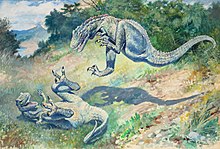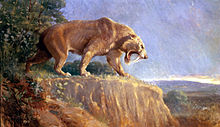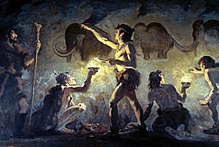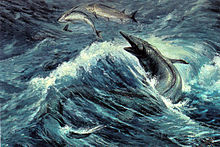art.wikisort.org - Artist
Charles Robert Knight (October 21, 1874 – April 15, 1953) was an American wildlife and paleoartist best known for his detailed paintings of dinosaurs and other prehistoric animals. His works have been reproduced in many books and are currently on display at several major museums in the United States. One of his most famous works is a mural of Tyrannosaurus and Triceratops, which helped establish the two dinosaurs as "mortal enemies" in popular culture. Working at a time when many fossil discoveries were fragmentary and dinosaur anatomy was not well understood, many of his illustrations have later been shown to be incorrect representations. Nevertheless, he has been hailed as "one of the great popularizers of the prehistoric past".
Charles R. Knight | |
|---|---|
 Photo from c. 1914 | |
| Born | October 2, 1874 Brooklyn, New York |
| Died | April 15, 1953 (aged 78) Manhattan, New York |
| Nationality | American |
| Known for | Painting |
Biography
Early life
Knight was born in Brooklyn, New York City.
As a child, Knight was deeply interested in nature and animals, and spent many hours copying the illustrations from his father's natural history books. Though legally blind because of astigmatism and a subsequent injury to his right eye, Knight pursued his artistic talents with the help of specially designed glasses, and at the age of twelve, he enrolled at the Metropolitan Art School to become a commercial artist. In 1890, he was hired by a church-decorating firm to design stained-glass windows, and after two years with them, became a freelance illustrator for books and magazines, specializing in nature scenes.
![Entelodon (then known as Elotherium), the first commissioned restoration of an extinct animal by Charles R. Knight.[1]](http://upload.wikimedia.org/wikipedia/commons/thumb/4/47/Knight_entelodont.jpg/220px-Knight_entelodont.jpg)
In his free time, Knight visited the American Museum of Natural History, attracting the attention of Dr. Jacob Wortman, who asked Knight to paint a restoration of a prehistoric pig, Elotherium, whose fossilized bones were on display. Knight applied his knowledge of modern pig anatomy, and used his imagination to fill in any gaps. Wortman was thrilled with the final result, and the museum soon commissioned Knight to produce an entire series of watercolors to grace their fossil halls. His paintings were hugely popular among visitors, and Knight continued to work with the museum until the late 1930s, painting what would become some of the world's most iconic images of dinosaurs, prehistoric mammals, and prehistoric humans.

One of Knight's best-known pieces for the American Museum of Natural History is 1897's Leaping Laelaps, which was one of the few pre-1960s images to present dinosaurs as active, fast-moving creatures (thus anticipating the "Dinosaur Renaissance" theories of modern paleontologists like Robert Bakker). Other familiar American Museum paintings include Knight's portrayals of Agathaumas, Allosaurus, Apatosaurus, Brontosaurus, Smilodon, and the Woolly Mammoth. All of these have been reproduced in numerous places and have inspired many imitations.
Knight's work for the museum was not without critics, however. Although he spent considerable time at zoos studying the movements and habits of living animals,[2] many curators argued that his work was more artistic than scientific, and protested that he did not have sufficient scientific expertise to render prehistoric animals as precisely as he did. While Knight himself agreed that his murals for the Hall of the Age of Man were "primarily a work of art," he insisted that he had as much paleontological knowledge as the museum's own curators.[3]
Nationwide attention

After Knight established a reputation at the American Museum of Natural History, other natural history museums began requesting paintings for their own fossil exhibits. In 1925, for example, Knight produced an elaborate mural for the Natural History Museum of Los Angeles County which portrayed some of the birds and mammals whose remains had been found in the nearby La Brea Tar Pits. The following year, Knight began a 28-mural series for Chicago's Field Museum of Natural History, a project which chronicled the history of life on earth and took four years to complete. At the Field Museum, he produced one of his best-known pieces, a mural featuring Tyrannosaurus and Triceratops. This confrontation scene between a predator and its prey became iconic and inspired a huge number of imitations, establishing these two dinosaurs as "mortal enemies" in the public consciousness. The Field Museum's Alexander Sherman says, "It is so well-loved that it has become the standard encounter for portraying the age of dinosaurs".[4]

Knight's work also found its way to the Carnegie Museums in Pittsburgh, the Smithsonian Institution, and Yale's Peabody Museum of Natural History, among others. Several zoos, such as the Bronx Zoo, the Lincoln Park Zoo, and the Brookfield Zoo, also approached Knight to paint murals of their living animals, and Knight enthusiastically complied. Knight was actually the only person in America allowed to paint Su Lin, a giant panda that lived at Brookfield Zoo during the 1930s.[5]
While making murals for museums and zoos, Knight continued illustrating books and magazines, and became a frequent contributor to National Geographic. He also wrote and illustrated several books of his own, such as Before the Dawn of History (Knight, 1935), Life Through the Ages (1946), Animal Drawing: Anatomy and Action for Artists (1947), and Prehistoric Man: The Great Adventure (1949). Additionally, Knight became a popular lecturer, describing prehistoric life to audiences across the country.
Eventually, Knight began to retire from the public sphere to spend more time with his grandchildren, who shared his passion for animals and prehistoric life. In 1951, he painted his last work, a mural for the Everhart Museum in Scranton, Pennsylvania. He died in New York City, two years later.
Legacy

Knight has been hailed as "one of the great popularizers of the prehistoric past", and as having influenced generations of museum-goers.[6] Examples of Knight's work frequently appeared in dinosaur books published in the US during the first half of the twentieth century and countless other artists and illustrators borrowed heavily from Knight's conceptions of dinosaurs and other prehistoric animals.[7] More recent works also include examples of Knight's paintings; for example, Stephen Jay Gould used one of Knight's paintings for the cover of his 1991 book Bully for Brontosaurus and another in his 1996 book Dinosaur in a Haystack. Though many other paleoartists have equaled Knight (perhaps Zdeněk Burian) Knight's paintings still remain very popular among dinosaur and paleontology enthusiasts. A commemorative edition of Knight's 1946 book Life Through the Ages ISBN 0-253-33928-6 was recently published by Indiana University Press, and a 2007 calendar ISBN 0-7649-3622-0 of Knight's paintings is also currently available. Additionally, fantasy artist William Stout has compiled a series of Charles Knight Sketchbooks, which contain many rare and previously unpublished drawings and studies by Knight.
![Knight's restoration of Agathaumas from 1897, which was later used as basis for a model Agathaumas used in the 1925 film The Lost World.[8]](http://upload.wikimedia.org/wikipedia/commons/thumb/3/35/Agathaumas.jpg/220px-Agathaumas.jpg)
Because Knight worked in an era when new and often fragmentary fossils were coming out of the American west in quantity, not all of his creations were based on solid evidence; dinosaurs such as his improbably-adorned Agathaumas (1897) for example, were somewhat speculative. His depictions of better-known ceratopsians as solitary animals inhabiting lush grassy landscapes were largely imaginative (the grasslands that feature in many of his paintings didn't appear until the Cenozoic). Although Knight sometimes made musculoskeletal studies of living animals, he did not do so for his dinosaur restorations, and he restored many dinosaurs with typical reptilian-like limbs and narrow hips (Paul, 1996). In the 1920s, studies by the celebrated palaeontologists Alfred Romer and Gerhard Heilmann (Heilmann, 1926) had confirmed that dinosaurs had broad avian-like hips rather than those of a typical reptile. Knight often restored extinct mammals, birds and marine reptiles in very dynamic action poses, but his depictions of large dinosaurs as ponderous swamp-dwellers destined for extinction reflected more traditional concepts (Paul, 1996). In his catalogue to Life through the Ages (1946), he reiterated views that he had written earlier (Knight, 1935), describing the great beasts as "slow-moving dunces" that were "unadaptable and unprogressive" while conceding that small dinosaurs had been more active. Some of his pictures are now known to be wrong, such as the tripod kangaroo-like posture of the hadrosaurs and theropods, whereas their spinal column was roughly horizontal at the hip; and the sauropods standing deeply in water whereas they were land-dwellers. Knight also drew dinosaur tails dragging on the ground, whereas they were held out approximately horizontally.

The late Stephen Jay Gould was one of Knight's most well-known fans, notably refusing to refer to Brontosaurus as "Apatosaurus" because Knight had always referred to the creature with the former name.[5] Gould writes in his 1989 book Wonderful Life, "Not since the Lord himself showed his stuff to Ezekiel in the valley of dry bones had anyone shown such grace and skill in the reconstruction of animals from disarticulated skeletons. Charles R. Knight, the most celebrated of artists in the reanimation of fossils, painted all the canonical figures of dinosaurs that fire our fear and imagination to this day".[9] Other admirers have included special effects artist Ray Harryhausen, who writes in his autobiography An Animated Life, "Long before Obie (Willis O'Brien), myself, and Steven Spielberg, he put flesh on creatures that no human had ever seen. […] At the L.A. County Museum I vividly remember a beautiful Knight mural on one of the walls depicting the way the tar pits would have looked in ancient times. This, plus a picture book about Knight's work my mother gave me, were my first encounters with a man who was to prove an enormous help when the time came for me to make three-dimensional models of these extinct beings".[9] Paleoartist Gregory S. Paul has also mentioned Knight as a big influence on him.[10] [11]
In 2012, a book about Knight and his art written by Richard Milner titled Charles R. Knight The Artist Who Saw Through Time was published.[12]
An homage to the painter was also made in the 1998 IMAX feature film, T-Rex: Back to the Cretaceous, in which he was portrayed by actor Tuck Milligan.
Works




Knight's works are currently included as part of the permanent collections of these colleges, libraries, museums, and zoos:
- Academy of Natural Sciences (Philadelphia, Pennsylvania)
- American Museum of Natural History (New York, New York)
- Bethune-Cookman College (Daytona Beach, Florida)
- Bronx Zoo (Bronx, New York)
- Carnegie Museum of Natural History (Pittsburgh, Pennsylvania)
- The Dinosaur Museum (Blanding, Utah)
- Everhart Museum (Scranton, Pennsylvania)
- Field Museum of Natural History (Chicago, Illinois)
- Florida Museum of Natural History (Gainesville, Florida)
- Illinois State Museum (Springfield, Illinois)
- Mesa Southwest Museum (Mesa, Arizona)
- Museum of the Earth (Ithaca, New York)
- National Museum of Natural History (Washington, DC)
- National Zoo (Washington, DC)
- Natural History Museum of Los Angeles County (Los Angeles, California)
- Princeton University (Princeton, New Jersey)
- Science Museum of Minnesota (Saint Paul, Minnesota)
- Sebring Public Library (Sebring, Florida)
- Yale Peabody Museum of Natural History (New Haven, Connecticut)
In addition, a touring exhibit, Honoring the Life of Charles R. Knight, was launched in 2003 and has visited several locations throughout the United States.
Publications
- Before the Dawn of History, 1935
- Life Through the Ages, 1946
- Animal Drawing: Anatomy and Action for Artists, 1947
- Prehistoric Man: The Great Adventurer, 1949
- Charles R. Knight, Autobiography of an Artist, 2005
See also
- Paleoart
- Wildlife art
Notes
- Stout 2005, p. ix.
- Graslie, Emily. "Paleoart: Painting the Land Before Time". Field Museum of Natural History. Retrieved 16 October 2021.
- Cain, Victoria. "'The Direct Medium of the Vision': Visual Education, Virtual Witnessing and the Prehistoric Past at the American Museum of Natural History, 1890-1923." Journal of Visual Culture, 2010, 9: 284, pp. 292-298.
- "Charles Knight: Prehistoric Visions of a Beloved Muralist" 2002 Field Museum, In the Field article by Alexander Sherman
- Butler, Emily Y. (October 2005). "Interview with Rhoda Knight Kalt" (PDF). Geospectrum. American Geological Institute. 5 (1). Archived from the original (PDF) on 2011-06-08.
- Berman, J. C. (2003). "A Note on the Paintings of Prehistoric Ancestors by Charles R. Knight". American Anthropologist. 105: 143–146. doi:10.1525/aa.2003.105.1.143.
- Stout 2005, p. xi. "There was scarcely a dinosaur book published in the first sixty years of the 20th century that did not include examples of Knight's work."
- Marcel Delgado: The Man Who Made Monsters Retrieved October 1, 2009.
- "Welcome to the World of Charles R. Knight".
- Morales, Bob (1999). "The PT Interview: Gregory S. Paul" (PDF). The Prehistoric Times (35). Retrieved August 21, 2016.
- Curley, Vince J.J. (2006). "The Prehistoric Times Interview:Gregory S. Paul" (PDF). The Prehistoric Times (75). Retrieved August 21, 2016.
- Parrish, M. A. (2012). "Grand Master of Reconstruction". Science. 335 (6071): 921. Bibcode:2012Sci...335..921P. doi:10.1126/science.1220073. S2CID 161289346.
References
- Heilmann, G. (1926). The Origin of Birds. London, H.F. & G. Witherby.
- Paul, G.S. (1996). The art of Charles R. Knight. Scientific American 274 (6): 74-81.
- Cain, V. (2010), "'The Direct Medium of the Vision': Visual Education, Virtual Witnessing and the Prehistoric Past at the American Museum of Natural History, 1890-1923", Journal of Visual Culture, 9 (3): 284–303, doi:10.1177/1470412910380334, S2CID 192988300
- Stout, William (2005). Introduction. Charles R. Knight: Autobiography of an Artist. By Knight, Charles Robert. G.T. Labs. pp. ix–xiii. ISBN 978-0-9660106-8-8.
- For Knight's dark side see: Brian Regal, Henry Fairfield Osborn: Race and the Search for the Origins of Man (Ashgate, 2002).
External links
- The World of Charles Knight, a website maintained by Knight's granddaughter Rhoda Knight Kalt (includes most of his paintings)
- Charles R. Knight biography at Field Museum website
- Charles R. Knight biography at American Museum of Natural History website
- Time Traveler: The Art of Charles R. Knight; March 26, 2012; Scientific American
На других языках
- [en] Charles R. Knight
[fr] Charles R. Knight
Charles Robert Knight (21 octobre 1874 à Brooklyn, mort le 15 avril 1953 à Manhattan), est un artiste peintre et illustrateur américain connu pour ses reconstitutions de scènes préhistoriques et principalement ses représentations de dinosaures. Ses œuvres furent reproduites dans plusieurs ouvrages et sont accrochées dans plusieurs musées des États-Unis. Elles ont influencé d'autres artistes comme Zdeněk Burian, Neave Parker, Frank Frazetta. Walt Disney fait référence à ses œuvres dans son film Fantasia, et le concepteur d'effets spéciaux Ray Harryhausen a témoigné de son admiration pour le peintre en préfaçant la réédition de l'autobiographie de Knight Autobiography of an Artist.[ru] Найт, Чарльз
Чарльз Роберт Найт (англ. Charles Robert Knight; 21 октября 1874, Бруклин — 15 апреля 1953, Манхэттен) — американский художник и иллюстратор, известный тем, что реконструировал внешний вид доисторических животных, в частности, динозавров. Его работы публикуются во многих изданиях по палеонтологии, выставлены во многих музеях США. Во многом он повлиял на таких последующих палеонтологов-иллюстраторов, как Зденек Буриан, Нив Паркер, Фрэнк Фразетта. В своём мультфильме «Фантазия» Уолт Дисней делает отсылки к его работам.Другой контент может иметь иную лицензию. Перед использованием материалов сайта WikiSort.org внимательно изучите правила лицензирования конкретных элементов наполнения сайта.
WikiSort.org - проект по пересортировке и дополнению контента Википедии